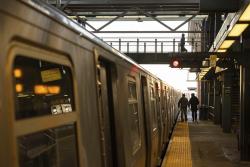While training with the F-35s is being carried out on land, the aircraft will eventually be transferred to the Japan Maritime Self-Defense Force’s (JMSDF’s) two Izumo-class destroyers.
The Japanese Air Self-Defense Force (JASDF) received on Thursday the first three of a planned 42 Lockheed Martin F-35B Lightning II, the short takeoff and vertical landing (STOVL) variant of the Joint Strike Fighter. According to Nikkei Asia, US military personnel flew the aircraft from the United States to Guam and then to Nyutabaru Air Base in the Miyazaki Prefecture.
One of the aircraft was recorded making a vertical landing at the base, where initial training operations will be carried out. Plans had called for the training to be conducted on the uninhabited Mage Island, but work on the JASDF’s infrastructure, notably the runways, has yet to be completed. It is unclear when that work will be finished, but it is likely not before 2029 or early 2030.
Japan is the largest F-35 operator after the United States, and its program of record calls for it to receive 105 F-35A models and 42 F-35Bs. A third F-35A squadron is currently being created.
The F-35’s Arrival in Japan Was Met with Protests
The arrival of the F-35B, which was announced in advance, drew several onlookers. However, not all of them were aviation buffs who were hoping to catch a glimpse of the fifth-generation stealth fighter making a vertical landing. Approximately 50 protesters—angry about the extent of Japan’s military cooperation with the United States, and America’s basing of US troops on Japanese territory—were also present. They held signs that criticized the training operations at the base.
As previously reported, the JASDF will carry out as many as 100 vertical landings monthly, including upwards of 40 at night. The training exercises have led to concerns over noise levels around the base. Each landing is expected to last around three minutes. These landings produce around 110 decibels, roughly the noise of a chainsaw or leaf blower, at 300 meters, and upwards of 130 decibels from 75 meters.
Tokyo had previously pledged that vertical landing exercises would not need to be carried out at Nyutabaru.
The New F-35s Will End Up on Japan’s Aircraft Carriers
While the training with the F-35s is being carried out on land, the F-35Bs will eventually be transferred to the Japan Maritime Self-Defense Force’s (JMSDF’s) two Izumo-class multipurpose helicopter-destroyers that are being converted to operate with the STOVL fighters.
Work will be completed on the JS Izumo and JS Kaga by 2027, allowing the warships to serve as Japan’s first aircraft carriers since the Second World War. That has not been without a fair share of controversy. Since the plan was first announced in 2018, to address the threat from Chinese expansion and aggression in the Indo-Pacific, there are concerns that it is contrary to the Japanese pacifist post-World War II constitution that bans the adoption of offensive weapon systems.
From the mid-2010s onward, Tokyo has opted to engage in a “reinterpretation” of the constitution’s Article 9, which nominally forbids Japan from entering war. Under the reinterpretation, however, Japan holds the right of “collective self-defense,” and can engage in military action if one of its allies were to be attacked.
Last fall, JS Kaga (DDH-184) was deployed to San Diego, where the soon-to-be aircraft carrier conducted F-35B training operations with the US Navy.
Despite the modifications to its helicopter destroyers, the JMSDF has remained cautious in its exact terminology, refraining from explicitly labeling the modified Izumo-class vessels as aircraft carriers.
However, the transformation of the warships has already drawn criticism from Beijing, even as its People’s Liberation Army Navy (PLAN) is carrying out sea trials of its third carrier, the Type 003 Fujian.
About the Author: Peter Suciu
Peter Suciu has contributed over 3,200 published pieces to more than four dozen magazines and websites over a thirty-year career in journalism. He regularly writes about military hardware, firearms history, cybersecurity, politics, and international affairs. Peter is also a Contributing Writer for Forbes and Clearance Jobs. He is based in Michigan. You can follow him on Twitter: @PeterSuciu. You can email the author: [email protected].
Image: Shutterstock / Faizinraz.


















